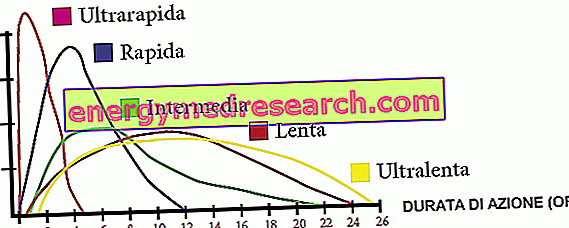Since it began to be used in therapy in the 20s of the last century, insulin has gradually transformed diabetes from a deadly disease into a manageable condition with increasing ease. Initially, bovine and porcine forms were used, with important risks of sensitization and allergic reactions, but starting from the 1980s a pure and identical insulin to human was started to spread. This protein substance is produced thanks to genetically modified bacterial strains to give it the ability to synthesize human insulin. Thanks to the further refinement of the pharmaceutical techniques, today the diabetic has at his disposal various types of insulins: ultra-fast analogues (insulin lispro and aspart), rapid (or normal), semi-thin, NpH, slow, ultra-slow and different premixed combinations of the previous ones. All thanks to the "simple" modification of some parts of the protein structure of human insulin produced by bacteria. The distinctive characteristics of the various types of insulin are essentially three:
- latency time (interval between administration and beginning of the hypoglycemic therapeutic effect);
- peak time (interval between administration and maximum hypoglycemic effect);
- duration of action (interval between administration and disappearance of the hypoglycemic effect).


To learn more: Complete list of articles on the site dedicated to insulin-based medicines
Ultra-fast insulin
Ultrarapid analogues (insulin lispro and aspart) come into action 10-15 minutes after injection, peak in 30-60 minutes and last about four hours. These characteristics make them ideal for taking with meals and allow the diabetic to cope with sudden and unexpected changes in his usual lifestyle.
Rapid insulin
Rapid (or normal) insulin has a half-hour latency, peaks in two to four hours and its activity disappears after four to eight hours. It is used before meals to control the hyperglycemia that follows food intake and to quickly lower the blood sugar level when it rises too much.
Semi-slow insulin
Semi-slow insulin comes into action after one to two hours, reaches peak action within two to five hours and becomes inactive in eight to twelve hours. Similar to the previous one, it is used to control postprandial hyperglycemia and is often associated with slow insulin.
NpH insulin
Insulin NpH (Neutral protamine Hagedorn) contains a substance (protamine) that slows its action; in this way the latency reaches two to four hours, the peak is produced six to eight hours after the injection and the total duration reaches 12-15 hours. Usually two injections per day allow sufficient glycemic control.
Slow insulin
The slow insulin, which contains zinc, has characteristics quite similar to the Nph: latency of one-two hours, peak of 6-12 hours and duration of 18-24 hours. Like the previous one, theoretically it allows satisfactory blood glucose control with only two daily injections.
Ultralent insulin
Ultralent insulin contains more zinc, which further delays its action. Thus, the latency rises to four to six hours and the peak to eight to fifteen hours, while the disappearance of the effect occurs after 18-24 hours. For this reason only one injection per day is enough, if necessary associated with small doses of rapid insulin (eg before meals).
Insulin glargine
There is also an analogue of ultralent human insulin, called insulin glargine, which has a latency of four to six hours, lasts more than 24 hours and is characterized by the absence of the peak (in other words, its activity remains constant for throughout the action). In some patients, only one injection a day of this product gets good blood glucose control.
Pre-made insulin mixtures
The pre-established mixtures (the most common are NpH: normal in the ratio 70:30 or 50:50) have an average latency of half an hour, a variable peak time according to the formulation and an action duration of up to 18-24 hours. Their use makes it possible to personalize insulin therapy to the maximum.
Which and how much insulin to use?
For a diabetic person, the therapeutic amount of insulin depends on various factors such as age, weight, movement, residual functional activity of pancreatic B cells and the amount of food absorbed during the day.

On a purely indicative level, you should use as many units of insulin a day as is the weight of the individual; this parameter, as well as the combination of different insulin preparations, depends on the therapeutic choice recommended by the doctor. Often, an attempt is made to mimic the physiological trend of a healthy person's insulinemia (click on the image to enlarge) characterized by a "basal" level (which has the function of regulating the production of glucose by the liver) and by spikes during meals. This pattern is roughly reproduced by combining fast-acting insulin (to manage the increase in prandial blood sugar levels, with injection just before each meal) with slow-acting insulin (for the management of glucose production in fasting conditions). Whatever the scheme undertaken, the collaboration of the patient is fundamental, who will have to learn to inject insulin (also the way in which the injection is performed is important for good glycemic control), to face emergencies, to respect the scheme, to monitor more take blood glucose and write down the changes daily, reporting any symptoms of hypoglycemia / hyperglycemia or changes in behavioral habits to the doctor.
The insulin pumps
Disposable syringes and preloaded pens (which can be used to inject more than just the needle) are now joined by so-called insulin pumps. These devices allow a subcutaneous infusion of the drug 24 hours a day, through a catheter connected to an insulin reservoir controlled by a computer (for basal secretion) and by the patient himself for the infusion of "boluses" (greater quantities of insulin in occasion of meals rich in carbohydrates or episodes of unexpected hyperglycemia).



